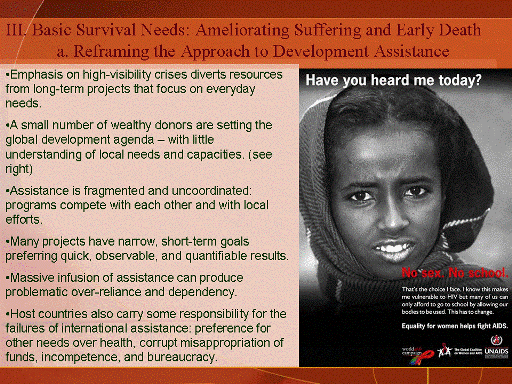Search for most updated materials ↑
| front |1 |2 |3 |4 |5 |6 |7 |8 |9 |10 |11 |12 |13 |14 |15 |16 |17 |18 |19 |20 |21 |22 |23 |24 |25 |26 |27 |28 |review |
 |
A. Reframing the
Approach to Development Assistance
Currently, international
development assistance is often driven by emotional, high visibility
events such as large-scale natural disasters, diseases that capture
the public’s imagination, or diseases with the potential for rapid
global transmission. These funding streams, however, skew
priorities, and divert resources from building stable local systems
to meet everyday health needs.
A relatively small number
of wealthy donors currently wield considerable influence in setting
the global health agenda. Although well meaning, this small group of
wealthy countries and philanthropists often sets priorities that do
not reflect local needs and preferences. Sometimes donors exert
control over the use of funds that discourages local leaders from
taking ownership. For example, the Bush Administration’s insistence
on abstinence, fidelity, and faith-based programs undermines
effective HIV prevention. Similarly, development banks have
encouraged or required poor countries to “cap” internal spending on
health as a condition of loans or debt relief. Donors often fund
politically popular projects, rather than what is most likely to
improve global health, leading experts to conclude, “Funding is
skewed towards what people in the West want to deliver.”
International health
assistance, moreover, is fragmented and uncoordinated. Relief
agencies and NGOs often establish programs that compete with each
other and, still worse, compete with local government and
businesses. Rather than integrating policies and programs within
local hospitals, clinics, and health agencies, they set up
state-of-the art facilities that overshadow and detract from
governmental and private enterprises. Foreign philanthropists can
offer salaries and amenities that are far more generous than those
that can be offered locally. As a result, local innovation and
entrepreneurship are stifled; talented individuals in business,
health care, and community development migrate to foreign-run
programs; and the local health industry cannot profit or easily
survive.
Many humanitarian
initiatives also set narrow, short-term goals that do not improve
basic infrastructure and create sustainable systems. Donors want
quick, observable, and quantifiable results. By focusing so
narrowly, often donors fail to see the long-term benefits of
building human resources and sustainable health systems.
Finally, and perhaps most
importantly, the massive infusion of humanitarian assistance into a
very poor countries can lead to reliance and dependency. If charity
is the main vehicle for health improvement, it means that local
government and businesses lose the desire and ability to solve
problems on their own. One day, the foreign cash, clinics,
medicines, and aid workers will leave. And when that happens, the
least healthy will be no better off, and perhaps worse off, unless
they gain the capacity to meet their own basic health needs.
It is important to stress
that host countries also bear responsibility for the failure of
international development assistance. Many poor countries spend a
minute percentage of their GDP on health, preferring to spend on the
military or other perceived needs. At the same time, some
governments misappropriate foreign health assistance, whether by
excessive bureaucracy, incompetence, or corruption. The World Bank
estimates that roughly half of all foreign health funds in
sub-Saharan Africa do not go for health services on the ground, but
are spent on payments for non-existent services, counterfeit drugs,
equipment diverted to the black market, or bribes.
|